
肌理と気配-Textures
2012年7月28日(土)~9月17月(月) 10:00 - 18:00/無料
air2012-2ja
野村誠
NOMURA Makoto

《根楽》、2012
サイズ可変
植物の根、ピアノ、紙(楽譜)
撮影:山本糾
育てる音楽
服部浩之
野村誠はあらゆる事象を音楽に変換する希有な才能をもつ作曲家だ。野村は独自の作曲法を探求することで、ランドアート、サウンドインスタレーション、屋外彫刻と異なった形式の作品を完成させ、眼で見ること、耳で聴くこと、身体で感じること、そして鑑賞者自らの手で作り出すことと、様々なレイヤーに渡る経験を生みだした。野村は生活そのものから音楽を生む。すべての作品は彼の生活を起点としてつながり、ひとつの物語を描く。身の回りのものを素材にするとか日常を異なった視点で捉えるというような手法の問題ではなく、日々の暮らしが音楽をつくり育てていくのだ。
野村の制作は、彼の京都での暮らしを青森でも継続することからスタートした。ミュージシャンでもある妻のやぶくみこをアシスタントとし、ふたりでACACに滞在し生活の延長線上で制作に取り組む。野村は昨年から畑を始めたという。始めたら畑仕事が非常に面白くて、生活のリズムを継続するためにも青森でのレジデンス中も続け、畑作業を作曲に変換したいという提案を投げかけてきた。少し驚いたが、ACACで畑をする絶好の場所としてすぐに宿泊棟屋上が浮かんだ。屋上庭園といえるような素敵ものではないが、20センチくらいの土が盛られ雑草が生い茂る70m×8mほどの細長い空間だ。野村のアイディアは、そこに5本の長い畝をつくり野菜を育て巨大な地上絵のような楽譜をつくり作曲をするというものだった。5本の畝を五線譜に、畝上で育つ野菜を音符に見立て、野菜が育つにつれて変化し成長する楽譜をつくるという。雑草が生い茂るこの痩せた未知の土地で農作業の初心者が畑をはじめるという、作品が成立すると信じられる要素などなにもない不安な状況下でも、野村は彼独特のおおらかさと魔術的な強い確信を持って、そんな環境を楽しむように、着々と淡々と制作に入った。
野村はこのプロジェクト型の作品を《音楽畑》と名付け、一週間かけて屋上を耕し、畝をつくり五線譜を描くことから始めた。次に、野菜や植物を植える位置をくじ引きによるチャンスオペレーションで決定し、様々な不測の事態や偶然をすべて受け入れながら農作業に取り組んだ。《音楽畑》は基本的に畑なので、いちど始めたらプロジェクト終了まではその世話はずっと続くことになる。朝夕の水やり、観察日記と草むしりは、野村夫妻、芸術サークル、ACACスタッフやボランティアの手で毎日続いた。観察日記は単なる記録だけではなく、日々の変化を他のメンバーに伝えるコミュニケーションツールとなった。何人かの異なった人が日記をつけることで、それぞれの視線や興味の違いが現れる。通常の畑のように同じ野菜をひとつの畝にたくさん植えるのではなく、楽譜としての面白さを実現できるようランダムに多種の野菜を植えるので、畑自体も密度が高すぎず構成美がある。開墾から展覧会開始まで約1ヶ月半の期間で野菜はよく育ち、五線の畝上に異なった大きさや色の様々な音符を実らせた。観客は《音楽畑》を宿泊棟手前にある創作棟から見下ろすように鑑賞する。創作棟の鑑賞ポイントには野村のオリジナルドローイングによる野菜(音符)の種類や配置などを示したスコアを乗せた譜面台を設置し、その奥にランドアートとしての作曲作品《音楽畑》が見える(fig.1-1, 1-2)。音符、つまり野菜たちの様子を確認できるように双眼鏡も幾つか設置した。
私も含めて多くの鑑賞者はこの《音楽畑》を見ても、その音色を思い描くのは難しい。だが、畑を耕して作曲をしているという状況を想像したり、野村自筆の愛らしいスコアを見てどんな野菜がどんな場所で育っているのかを眺めるのは、創造性を刺激されてなかなか楽しいものだ。ある音楽家のことばに「何でも音楽として聴けば音楽になる。」というものがある。それは、音楽を享受する観客が感覚を研ぎ澄まし創造する力を磨けばすべてが音楽として聴こえ、世界はもっと面白いものとして捉えられる、と解釈することもできると思う。子供たちなど音楽の専門家ではない人の発する音に面白みや美しさを発見する野村誠は、まさにこの「何でも音楽として聴ける」高い能力を備えているのだ。
野村誠は自然に他者と魅力的な関係を築く。しょうぎ作曲[i]や《プールの音楽会》[ii]など、これまでの彼の活動を参照いただけばそれは容易に理解できると思う。今回の作品も、頭のなかでの完璧な計算に基づいて作曲するのではなく、様々な人との出会いや共同作業を通じて完成されたものだ。《音楽畑》を守る「かかし」は、同時期にACAC滞在中だったアーティストの淺井裕介にデザインを依頼し、淺井展を機に生まれた青森公立大学芸術サークルのメンバーが1000円という限られた予算で2体制作した(fig.2)。また、野村不在時の畑の世話も芸術サークルに一任した。もちろん野村はただ色々な人に制作のサポートを依頼しているのではなく、ちゃんとその相手に様々なものを返している。例えば淺井展のためには、彼の空間とコラボレーションするように舞踏家との競演によるパフォーマンスを披露したり、芸術サークルに対してはプリペアドピアノの体験の機会を提供したり、音楽畑で収穫した野菜で食事を振る舞ったりと、金銭や損得勘定によらないフェアな交換関係を築いている。また、《音楽畑》は展覧会期中に公立大学吹奏楽サークルと市内中学校の吹奏楽部の生徒たち総計40人により演奏され(fig.3)、《根楽》という作品は地元音楽家による弦楽三重奏とのコラボレーションを実現した(fig.4)。ただ作曲して終わるのではなく、その変化を楽しみながら様々な人と共有し味わうのだ。ゆったりと構え、あせらず作品を育てていく。そのプロセスはとても美しい。
野村は滞在中に3点の作品を制作したが、その作品同士のつながりも非常に面白い。《音楽畑》のために雑草で覆われた屋上を開墾する際に、縦横無尽に広がる根っこのかたちに面白みを発見し、引っこ抜いた雑草の根を組み合わせて自由な弧を描くのびやかな五線譜を壁画のように生み出した。観客が演奏することにより完成するサウンドインスタレーション《根楽》(fig.5)。ギャラリー中央にはピアノを置き、譜面台には《根楽》の演奏法を記した簡単なインストラクション(指示書)を設置して、5つの鍵盤に1〜5の番号を添える。ト音記号の譜面と定め、五線上の音は下から順に「ミソシレファ」とする。野村はここで巧みにささやかな味付けを加える。ファを半音あげてファシャープとしたのだ。半音あげることで音色に複雑さが生まれる。あとは、観客がピアノの前に座って指定された5つの音を楽譜に沿って演奏していくのみというシンプルなものだ。インストラクションは子供でも理解できるもので、それに従って壁面の楽譜を読み一音一音味わうように演奏すればよい。演奏者はギャラリーの独特な音の反響により心地よく空間を巡る音に酔いしれる。一度ピアノの前に座ると、ついつい何度も演奏してしまう甘美な音空間が広がる。誰もが自らの手で美しい音を奏でられるという果てしない満足感に満たされる場だ。
そして最後の一点は、《レタスピアノ》という、風がピアノを弾く作品だ(fig.6)。これは野村が2004年に開催した「火の音楽会」の際に用いた壊れたピアノを青森に運び、そのピアノの供養の意味も込めて森の中にインスタレーションとして設置した屋外彫刻だ。鍵盤が取り除かれた場所に土を敷きレタスの種を植え、壊れてはずれたピアノのハンマーを樹上から吊り下げ、風が吹く毎にそれがピアノの弦をたたき音を奏でる。ほんの弱い風でもハンマーは弦にふれ、ささやかな音をたてる。静かだけれども味わい深い、環境に埋没するような作品。
この作品のタイトル《レタスピアノ》はことば遊びから生まれたもので、"Let us play the piano."というフレーズを、音の響きが似ているが全く意味の異なる"Lettuce play the piano."とダジャレのように読み替え、それを英語タイトルとし、日本語名も音を優先して《レタスピアノ》とした。野村はだじゃれをも音楽に変換する。だじゃれは音を軽妙に扱ったもので、音の純粋なつながりやずれがおかしみを生み出す。このような些細な日常の戯れにも美を見出し、人が経験できる音楽に変換してしまうあたりが野村誠という音楽家の魅力のひとつだ。
ちなみに、《音楽畑》は8月あたりから本格的に野菜が実り、野村の滞在後半はこの音楽畑からの収穫のみで日々の食事が賄えるようになった(fig.7)。さらに音楽畑は野村の次のタームのレジデンスアーティストたちに引き継がれ、彼らにもその収穫物を提供した。11月中旬に雪が降り始めるまで収穫は続き、12月現在はひとまずその役目を終えた畑は雪に覆われている。日常生活に端を発しているといえど、音楽作品をつくるために営まれた《音楽畑》が、最終的には生きるために必要不可欠な食事までも供給するという相互性は、ある意味生活と芸術の関係の究極の在り様ではなかろうか。生活そのものが創作行為を生み、また逆に創作活動が生活をつくるという野村の創造的な生き方は、現在の世界を生き抜く大事な糸口を提示していると思えてならない。「何でも音楽として聴けば音楽になる。」ということばをいかに受け取るかと同様に、野村の創造行為から何を得るかはあなた次第ということだ。
***
滞在制作作品
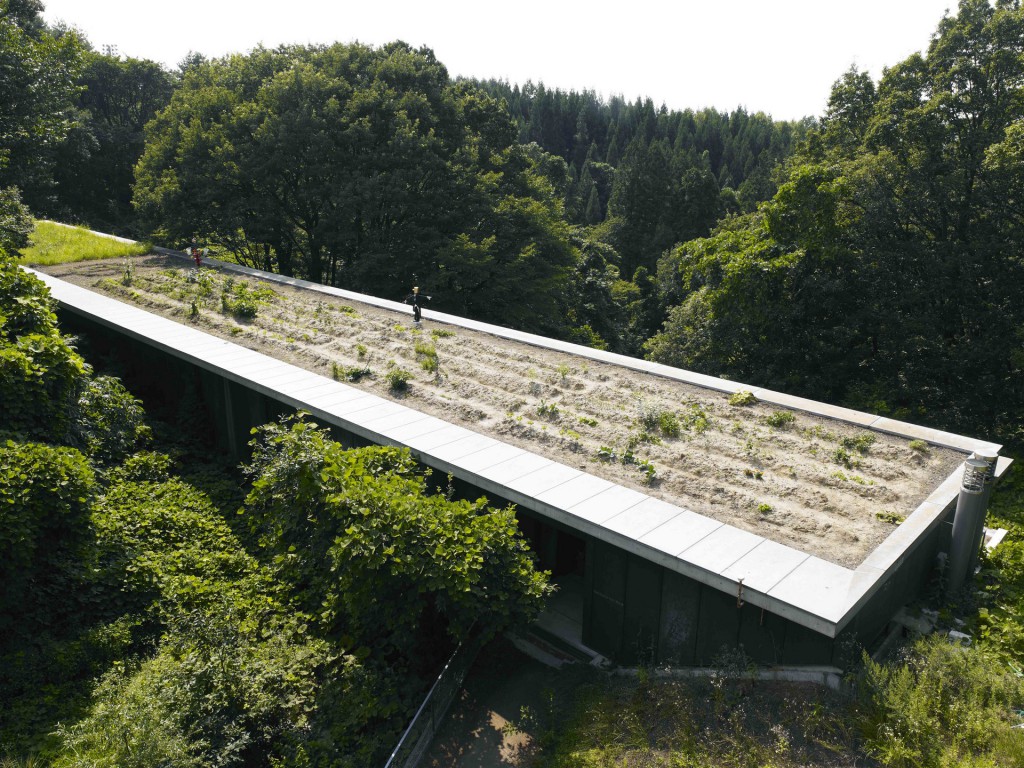
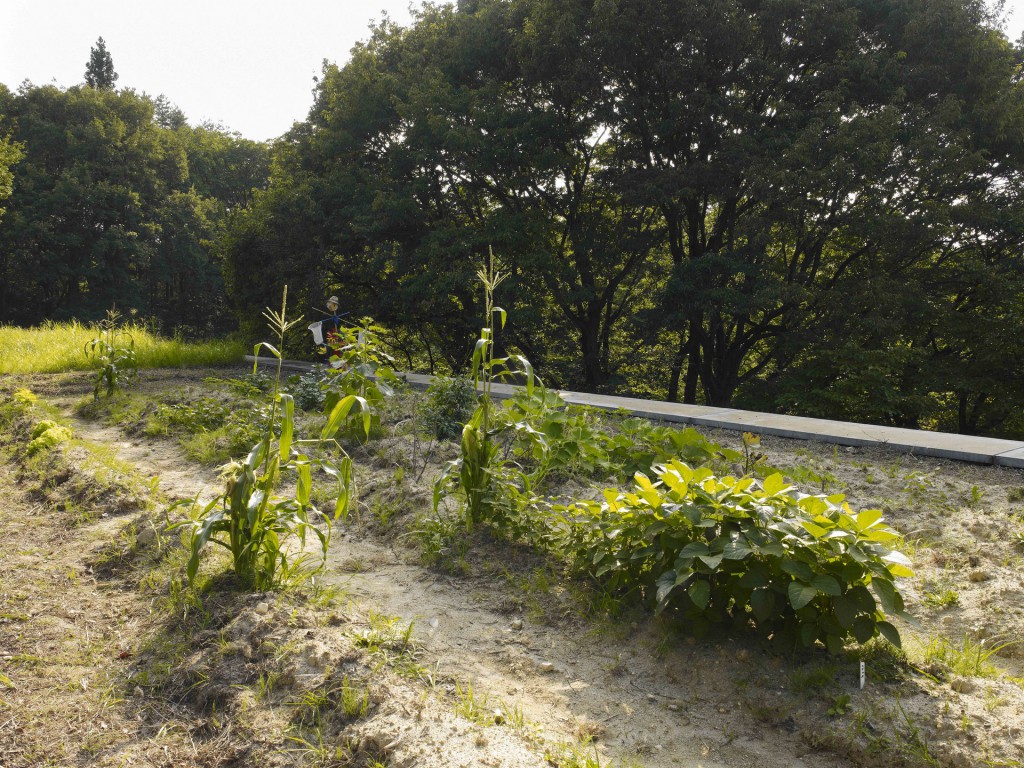 《音楽畑》、2012
《音楽畑》、2012
735×4000cm
畑、野菜、かかし、看板
撮影:山本糾
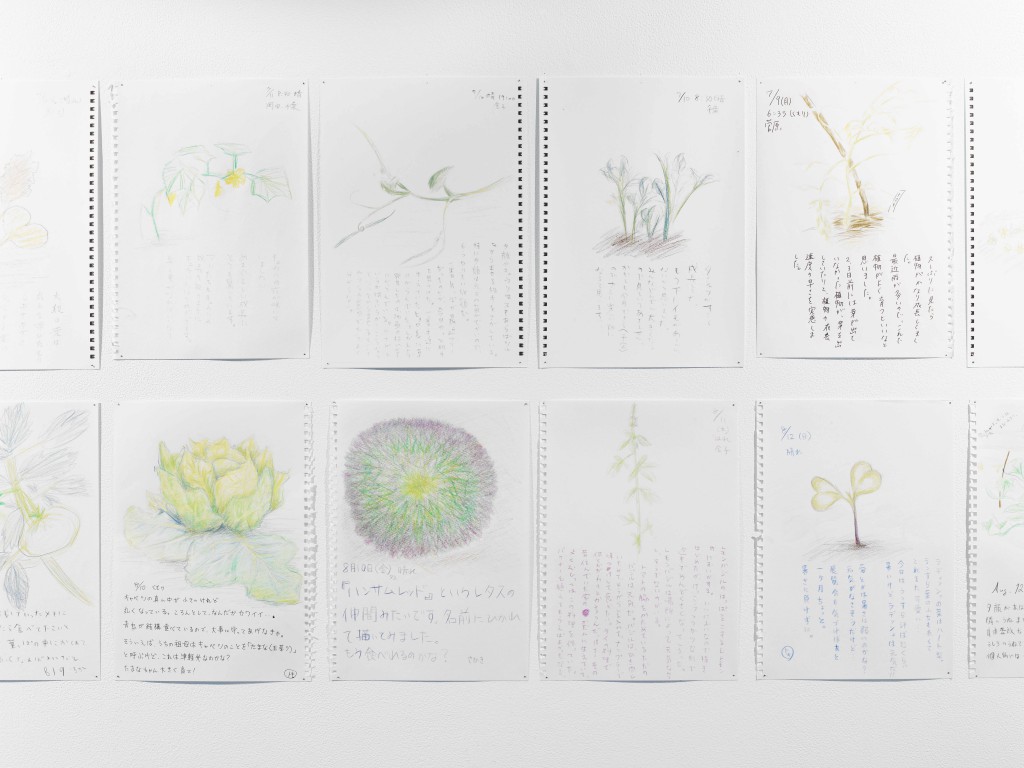 《音楽畑の観察日記》、2012
《音楽畑の観察日記》、2012
サイズ可変
紙、鉛筆
撮影:山本糾
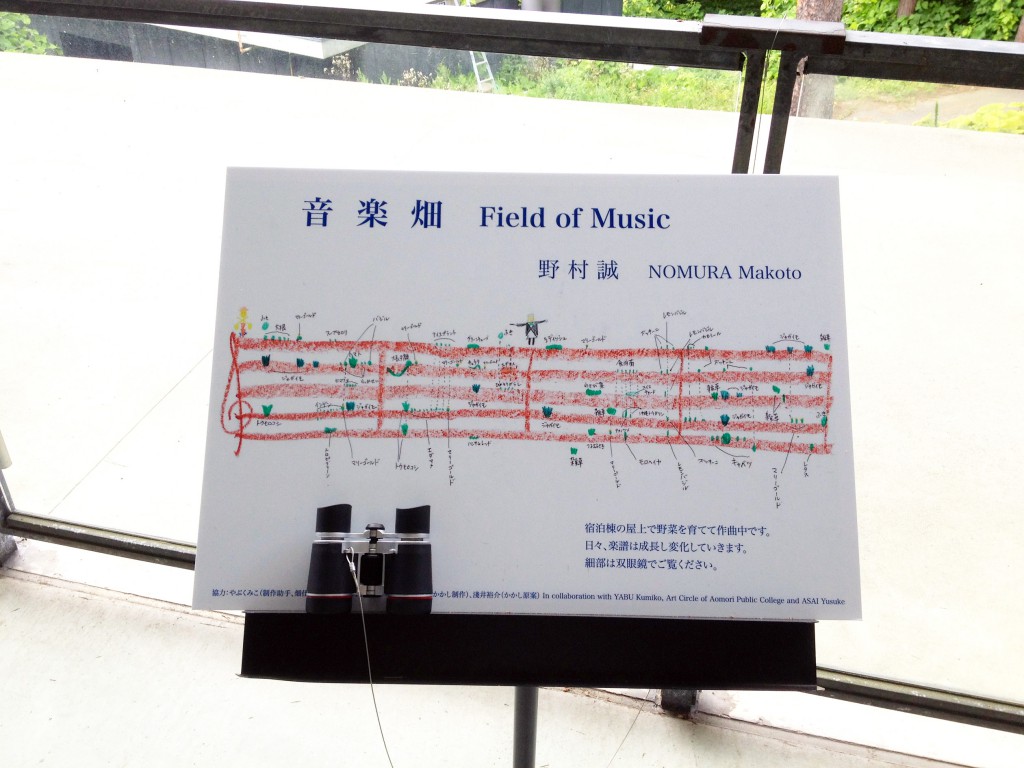 《音楽畑》スコア、2012
《音楽畑》スコア、2012
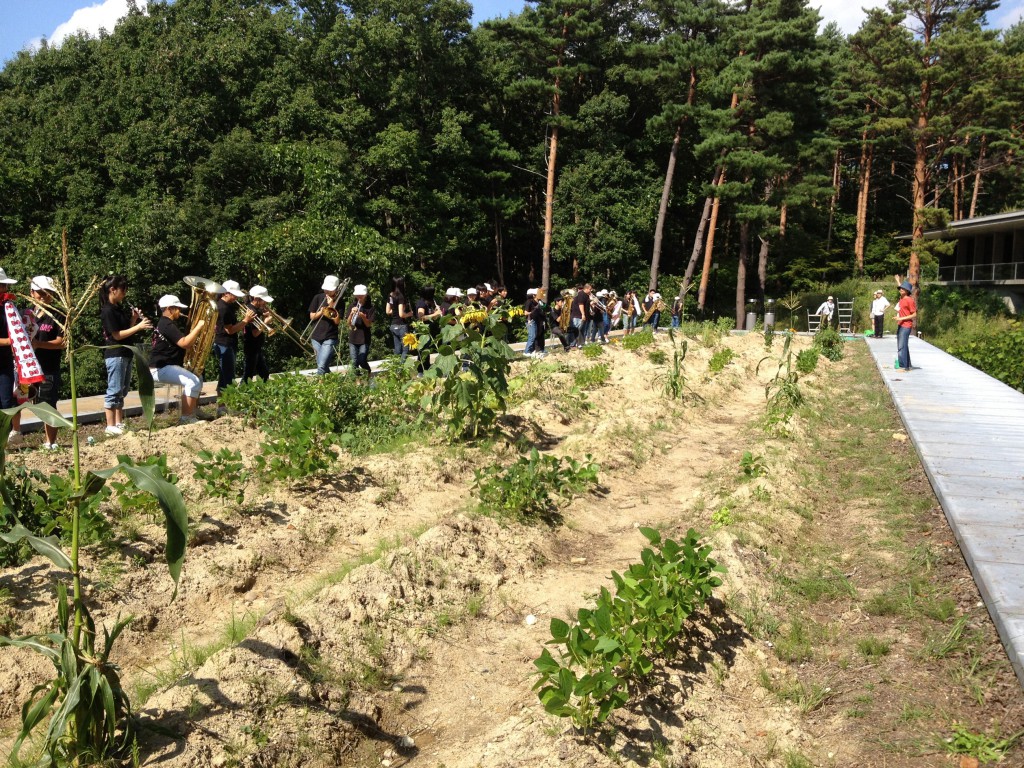 「畑の音楽会」
「畑の音楽会」
2012年9月8日(土)14:30~
指揮:野村誠、演奏:青森公立大学吹奏楽サークル7名、筒井中学校吹奏楽部29名
吹奏楽団による《音楽畑》の演奏の様子。
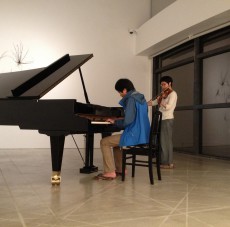
野村誠
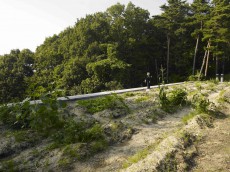
fig.1-1《音楽畑》全景
撮影:山本糾

fig.1-2《音楽畑》スコア
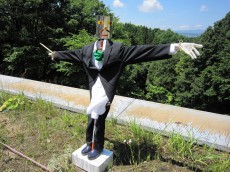
fig.2《音楽畑》のかかし
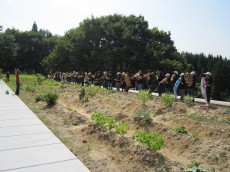
fig.3《音楽畑》の吹奏楽団による演奏
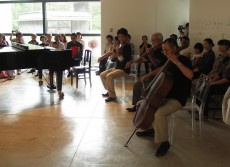
fig.4《根楽》の弦楽三重奏による演奏
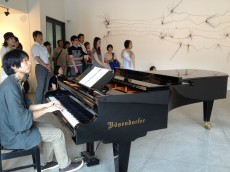
fig.5《根楽》を演奏する野村誠
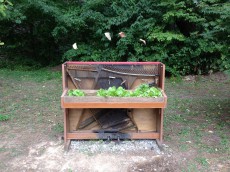
fig.6《レタスピアノ》

fig.7収穫物
Texture and Sense (Kime to Kehai)
July 28 (Sat) ~ September 17 (Mon), 2012 10:00 - 18:00 / Free
NOMURA Makoto
野村誠

Root Music, 2012
Dimension variable
Roots of plants, Piano, Instruction paper
Photo: YAMAMOTO Tadasu
Music Farming
HATTORI Hiroyuki
NOMURA Makoto is a composer who has a rare talent to convert all phenomena whatever into music. Exploring his own compositional method, he has created works of different forms including land-art, sound installation and outdoor sculpture, which make multilayer experiences possible such as visual, auditory, and physical, including production with the viewer’s own hands. Nomura produces music from life itself. All his works are connected to his life as a starting point, and tell us stories. Nevertheless, his methodology is not simply using his personal belongings as materials or giving a new perspective on his daily life. His day-to-day life itself creates and develops music.
Nomura’s residency work in Aomori started with his normal lifestyle in Kyoto. With his wife and assistant, musician YABU Kumiko, he stayed at ACAC to tackle his production on the extension of his daily life. He said he started farming last year. As he considered working in a vegetable patch very interesting, he approached ACAC with a proposal of converting farm work into music for the residency program in Aomori so that he could keep up with the rhythm of his life. Though the proposal was a little surprising, we thought the rooftop space of the accommodation building would be a great place for farming. It is not such a nice place as so-called roof garden, but it is a strip of land of about 70x8 square meters with 20cm-high raised ground overgrown with weeds. Nomura’s idea was to make five long ridges there to grow vegetables, make a musical score like a huge geoglyph and compose music. The five ridges are likened to musical score while vegetables are to musical notes, so that he can create a score that will change and develop as vegetables grow. It was hard to believe that he could achieve his aim under such unstable conditions that this beginner of farming wanted to cultivate the unknown, unproductive land overrun with weeds. He began to work, however, steadily and indifferently with his unique cool mindedness and strong magical conviction as if he were enjoying the environment like that.
Nomura named this project work Field of Music. To begin with, he spent a week plowing the land and making ridges for staff notation. Then he chose by lot where to plant vegetables under chance operation. Complying with all different contingencies and accidents, he tackled farming. As the Field of Music is basically a field, he had to take care of it all the time from the start until the project was over. Mr. and Mrs. Nomura, the art circle of Aomori Public College, ACAC staff and volunteers worked every day watering in the morning and evening, weeding and keeping the observation diary. The observation diary served as not only a documentary record but also a communication tool to inform other members of daily happenings. As several different people wrote the diary, differences in each one’s viewpoint and their interests became apparent. It was different from normal fields where many of the same kind of vegetables were planted along each ridge. In order to give the appeal as a score, a variety of vegetables were randomly planted. Consequently, in the field was a compositional beauty with low density. In one and a half months between the reclamation work and the start of the exhibition, vegetables grew well and showed musical notes of different sizes and colors. Looking down from the production building in front of the accommodation building, visitors could enjoy the bird’s-eye view of this Field of Music. Displayed at the viewing point in the production building was a score on a music stand showing the kinds and arrangements of vegetables (notes) originally drawn by Nomura. Visitors could see, behind it, Field of Music, his work composed as land-art. (fig.1-1,1-2) Binoculars were provided for viewers to see how vegetables, that is notes, were growing.
It is difficult for many viewers including myself to imagine tones by only looking at this Field of Music. However, it is fun and stimulates creativity to imagine how he plowed the field and wrote the musical score, and to see what vegetables are growing and where they are growing, following his lovely autograph score. One musician said, “If you listen to whatever as music, it is music.” This remark can be interpreted that if the audience who enjoy music sharpened their senses and polished their creativity, the world would be far more interesting because everything might sound like music. Nomura, who discovers beauty and fun in sounds made by children and those who are not experts in music, has outstanding capacities to be able to “listen to whatever as music.”
He can naturally build attractive relationship with others. You will easily understand it if you refer to his activities so far including Shogi music[1] and Concert in a swimming pool.[2] As for his work this time, the composition was not based on the flawless calculation in his mind but accomplished through the encounter and collaboration with many people. For “scarecrow” to protect the Field of Music, he asked artist ASAI Yusuke, who was staying at ACAC during the same period, to design it. Members of the art circle of Aomori Public College, which was formed on the occasion of the ASAI exhibition, made two scarecrows on a limited budget of \1,000 (fig.2). In addition, the same art circle took care of the field when Nomura was absent. What he did was not only asking many people to support his production, but also repaying them for their support in different ways. For the ASAI exhibition, for instance, he conducted a performance with a butoh dancer as spatial collaboration. For art circle members, he provided them with the opportunity to experience a prepared piano. What is more, he prepared meals using vegetables harvested in the Field. He does not act through mercenary motives to build a fair exchange relationship. During the exhibition period, a concert of the Field of Music was performed by a wind orchestra composed of a total of 40 people from the brass band of Aomori Public College and the brass band of junior high school students in the city (fig.3). Also for his piece named Root Music, collaboration with a string trio of local musicians was realized (fig.4). He does not end up only with writing the music. He also enjoys appreciating the change in the process and sharing the pleasure with many people. Acting in a relaxed manner, he does not rush to grow his work. This production process is attractive.
During the residency period, he created three works, and the connection between them is interesting. When he was plowing the land on the roof covered with weeds in order to produce Field of Music, he thought that the patterns of the freely spreading roots were charming. So he made combinations of the pulled-up roots of the weeds to create staff notation with flowing curved lines, which looked like a mural. Sound installation Root Music is completed when a visitor plays it. (fig.5) There is a piano in the center of the gallery, and on the music stand is an instruction paper explaining how to play the Root Music. Five keyboards are numbered 1 to 5. The music is written in treble clef, and sounds on the staff are E, G, B, D and F from the bottom up. Here he skillfully adds a little seasoning. He raises F by semitone to make it F sharp. Complex tones emerge by the raised semitone. What all performers have to do is to simply play five specified sounds following the score. As the instruction is easy enough for even a child to understand, all he or she has to do is to read the music on the wall following the instruction, and play carefully concentrating on each sound. Unique sound echoes in the gallery space let the performer self-absorbed in the pleasantly flowing sound. Once you sit in front of the piano, you will be tempted to play repeatedly in this pleasant space of sound. Because anyone could play beautiful sounds with their own hands, it was a place where they could feel everlasting satisfaction.
The last piece is Lettuce Play the Piano played by the wind. (fig.6) It is an outdoor sculpture put up as an installation in the forest in order to thank for the broken piano, which was used in his “Concert of Fire,” held in 2004, and brought to Aomori on this occasion. The place where the keyboards had been was filled with soil to sow lettuce. The broken-away piano hammers suspended from a tree play the sound hitting piano strings when the wind blows. Even a gentle breeze makes the hammers hit the strings and faint sounds are heard. This work is quiet but profound, and seems to blend into the environment.
As you can see, the title Lettuce Play the Piano is coined as wordplay. “Lettuce Play the Piano” comes from the phrase “Let us play the piano,” which has the similar sound but a completely different meaning. “Lettuce Play the Piano” is the title in English, and its Japanese title is “retasu piano” as the sound was given priority. Nomura is able to convert even a pun into music. In a sense, a pun is a witty use of sound, and pure connection or difference between sounds produce humor. He finds beauty even in everyday bit of fun, and converts it into music in which people can participate. That is one of the charms of Nomura as a musician.
The growth of vegetables in the Field of Music was on a full-scale around August, and in the latter half of his residency period, he could provide daily meals using only harvests from this field of music. (fig.7) What is more, the field of music has been passed on to artists taking part in the next residency program, giving harvests to them. Harvesting continued until it began to snow in mid-November, and now in December, the field that has finished its role for a while is covered with snow. Field of Music, which started as having its roots in everyday life, was primarily made for the production of music. Eventually it could provide meals to live. In a sense, this reciprocity between life and art suggests the ultimate state of the relationship between the two. Nomura’s creative life shows us that life itself is linked to creative acts, and conversely, creative activities make up life. I strongly feel that his way of life presents a significant clue for us to survive today’s world. How you learn from his act of creation is up to you in a way similar to how you interpret the phrase, “if you listen to whatever as music, it is music.”
Translated by NISHIZAWA Miki
[1] Methodology of collaborative composition that Nomura invented in 1999
[2] Composition commissioned for Aichi Triennale 2010
***
The Works produced in ACAC.

 Field of Music, 2012
Field of Music, 2012
735×4000cm
Vegetable field, Vegetables, Scarecrow, Signboard
Photo: YAMAMOTO Tadasu
 Diary of Observations on Field of Music, 2012
Diary of Observations on Field of Music, 2012
Dimension variable
Paper, Pencil
Photo: YAMAMOTO Tadasu
 Score for em>Field of Music, 2012
Score for em>Field of Music, 2012
 Concert of Farm
Concert of Farm
2:30pm -, September 8, 2012
Roof top of the Residential Hall, Gallery B
Performed by NOMURA Makoto (Conduct, Piano), Aomori Public College Brass Band Circle member, Tsutsui Junior High School Brass Band Club students
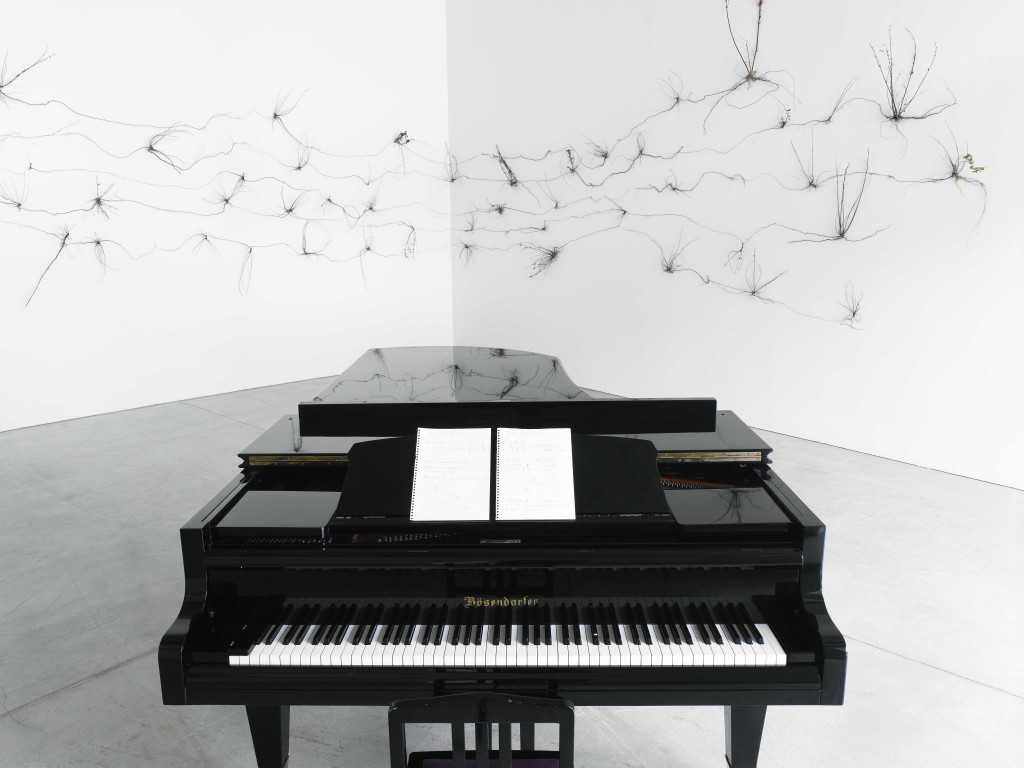
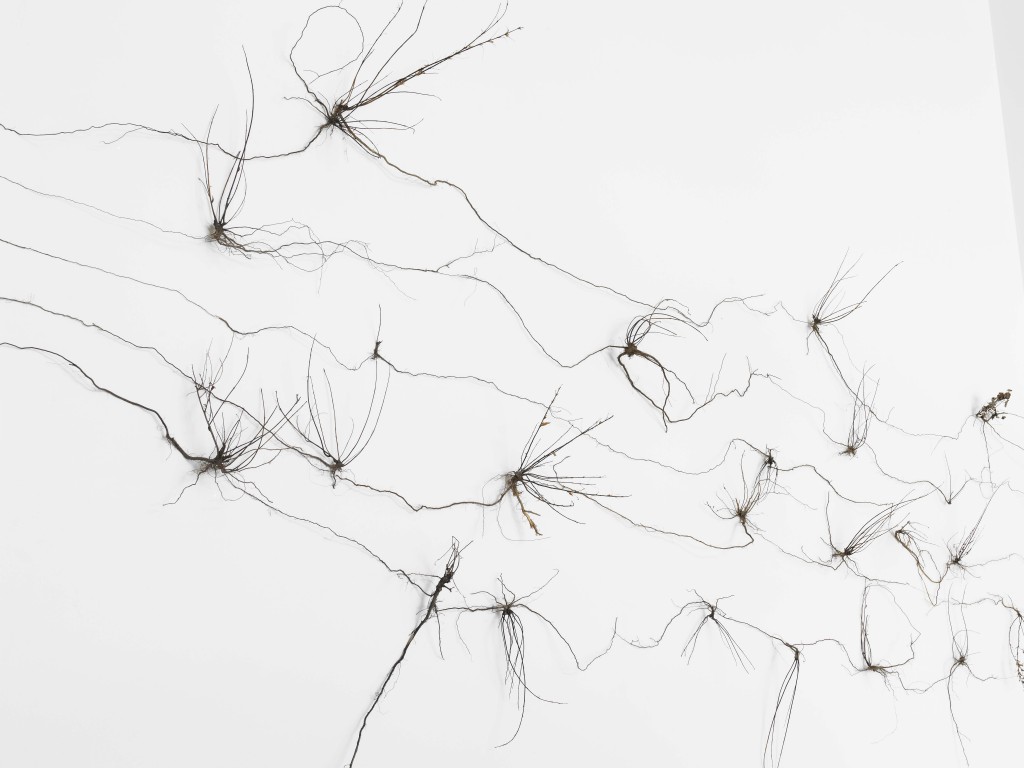

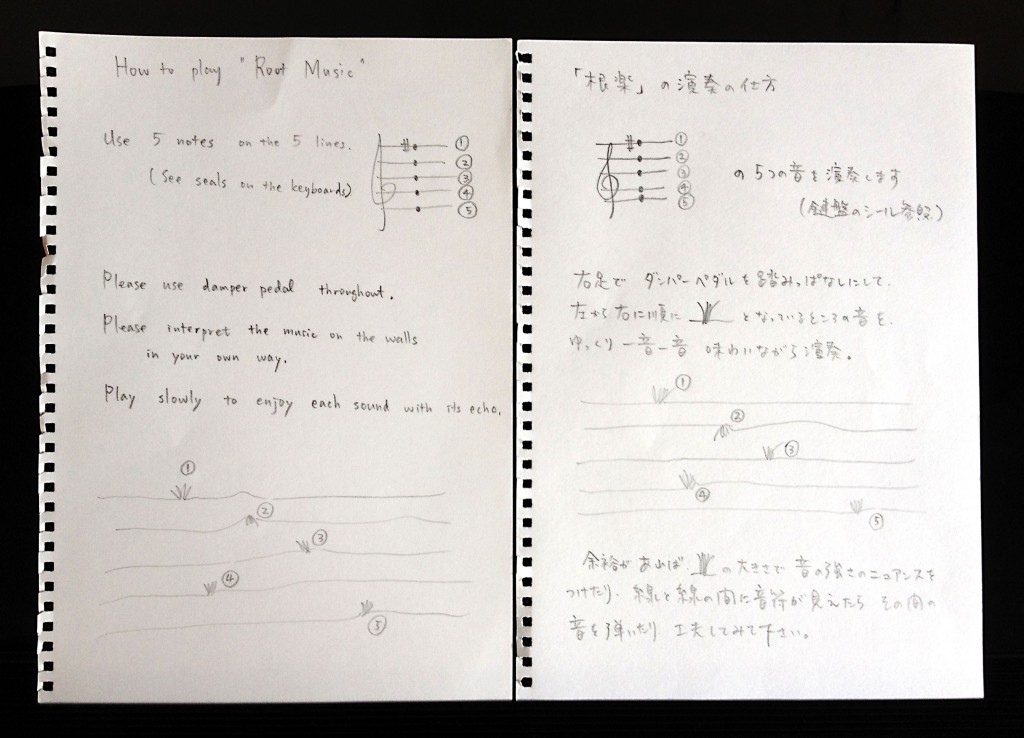 Root Music, 2012
Root Music, 2012
Dimension variable
Roots of plants, Piano, Instruction paper
Photos were taken by YAMAMOTO Tadasu, except the photo of score.
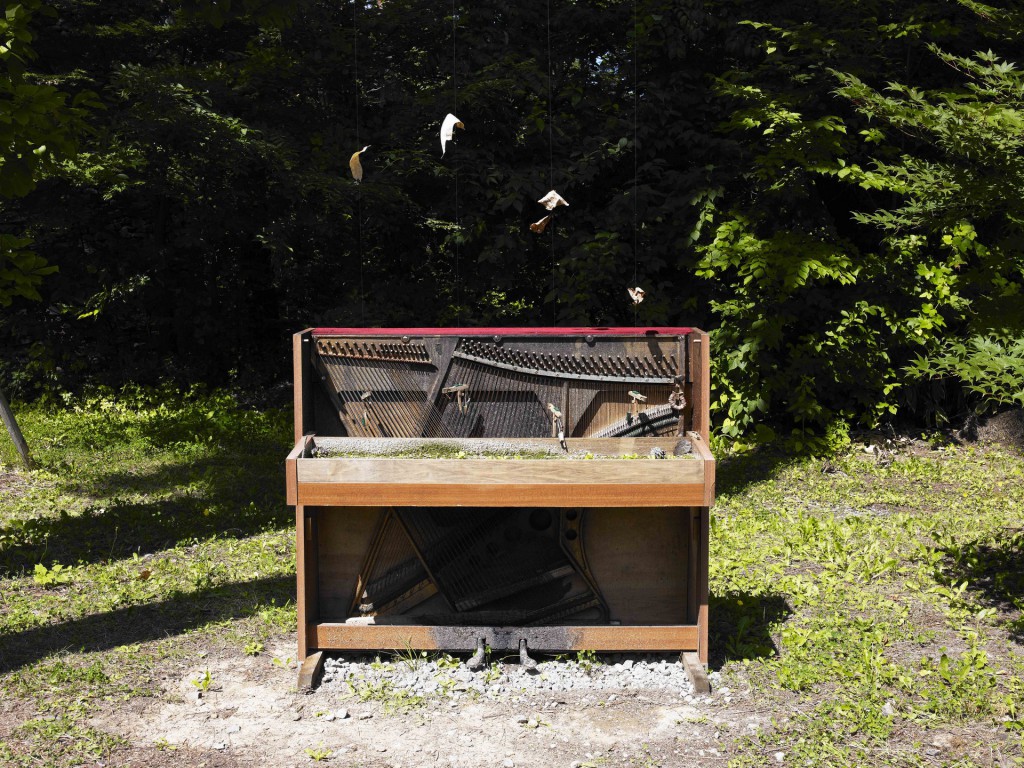
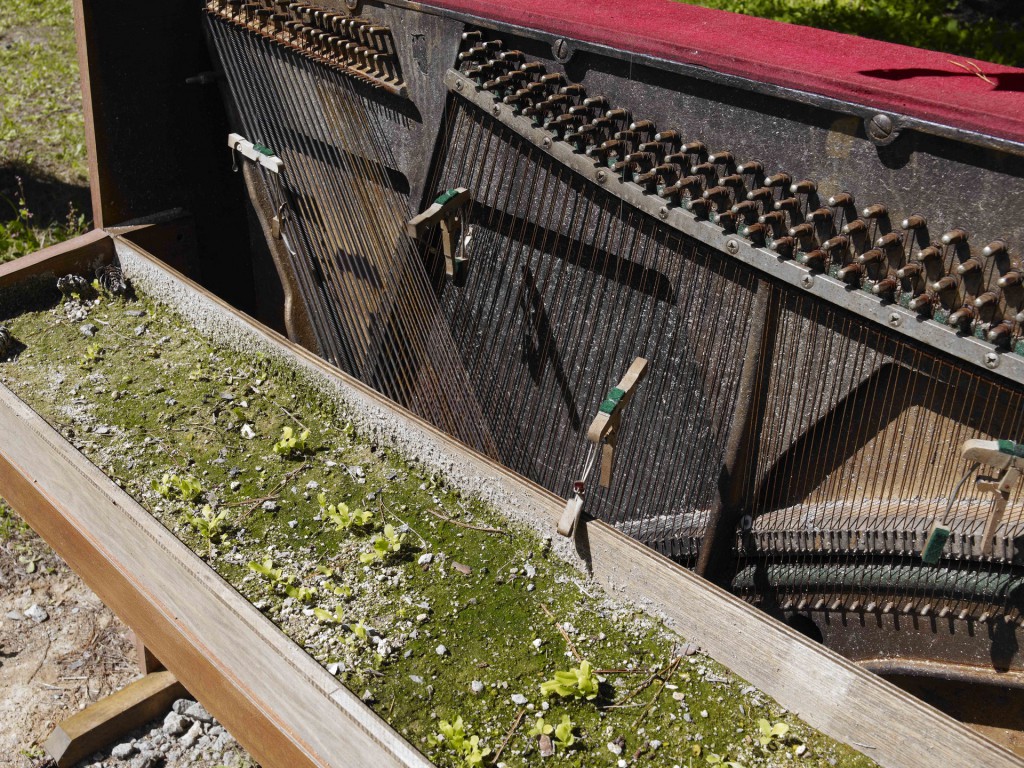 Lettuce Play the Piano, 2012
Lettuce Play the Piano, 2012
80×117×100㎝
Broken upright piano, Soil, Lettuce
Photo: YAMAMOTO Tadasu

NOMURA Makoto

fig.1-1 The bird view of Field of Music
Photo: YAMAMOTO Tadasu

fig.1-2 The score for Field of Music

fig.2 Scarecrow for Field of Music

fig.3 Concert by the wind orchestra

fig.4 Collaboration with string trio

fig.5 Nomura Makoto plays Root Music

fig.6 Lettuce Play the Piano

fig.7 Harvests from Field of Music
